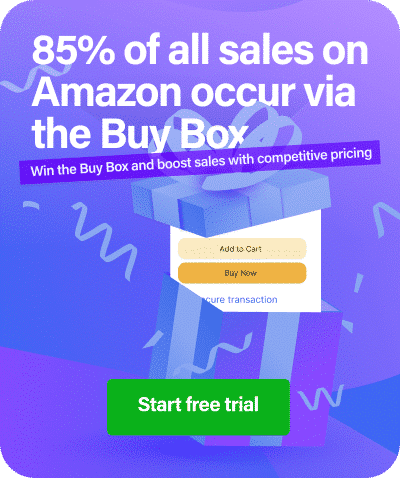In the battle for visibility (and profit) on Amazon, winning the Buy Box can make or break your revenue. This we all know. But when you’re investing in Amazon PPC and repricing software simultaneously – and, let’s be honest, putting time and money into both – it’s only natural to question which has more impact.
Do ad dollars win you more real estate than smart pricing?
Or does your pricing optimization ultimately push you to the top?
The aim of this article is to break down how Amazon PPC and automated repricing affect your chances of owning the Buy Box (and how they can work together to help you win it more often …which is the golden goose, right?).
The Buy Box: Why It Matters
Amazon’s Buy Box isn’t just a product detail box. No, no, no.
It’s a high-converting, algorithm-driven space that gives one seller prime placement on any given listing. And it works.
The proof’s in the pudding here… roughly 82% of Amazon sales go through the Buy Box. And for mobile shoppers, that figure is even higher. If you’re not there, your visibility drops fast, along with your conversions. The Buy Box matters.
If you aren’t up to speed on any of this, or you simply want to learn more about winning the Buy Box and why it should be a core focus in your growth strategy, we’ve got you covered.
Understanding Amazon PPC
Amazon PPC (Pay-Per-Click) is Amazon’s internal advertising system. Sellers bid on keywords to have their products appear in sponsored placements.
And if you get it right, Amazon PPC gets your listing in front of more buyers.
But there’s a catch.
That being that advertising alone doesn’t guarantee Buy Box ownership, sadly.
This is because it’s entirely possible to pay for a top-of-page ad and still not win the Buy Box if your price, shipping, or seller metrics don’t stack up.
But PPC does still play a critical role, because better visibility leads to more sales, which improves your rankings, credibility, and chances of winning the Buy Box.
Which is where your bid strategy matters. Overbidding may burn your advertising spend, especially if your offer isn’t competitive enough to convert. Underbid, on the other hand, and you miss impressions altogether. Not ideal in either direction, we think you’ll agree.
In short, PPC boosts ‘discoverability’, but doesn’t directly control the Buy Box algorithm.
What Repricing Does Differently
Repricing focuses on the single biggest direct lever in the Buy Box equation: price.
Amazon’s algorithm weighs price, seller rating, shipping speed, stock levels, and more, but price remains one of the heaviest factors. Automated repricing tools help you stay competitive in real-time by adjusting your offer based on competitor behavior, demand shifts, or performance thresholds.
That dynamic pricing control isn’t just reactive, it’s strategic. Tools like Repricer let you:
- Set pricing rules to avoid a race to the bottom
- Stay just under your competition, not miles below
- Protect your profit margins (even during periods of intense competition, like Black Friday or seasonal sales peaks)
Want to understand how price fits into the overall equation? Read more about the Amazon Buy Box algorithm.
Amazon PPC vs Repricing: Which Impacts the Buy Box More?
The easiest way to answer this is to give you a direct comparison:
| Factor | Amazon PPC | Repricing |
| Directly impacts Buy Box? | ❌ No | ✅ Yes |
| Drives visibility? | ✅ Yes | ❌ No |
| Influences conversion? | ✅ Indirectly | ✅ Directly |
| Affects listing price? | ❌ No | ✅ Yes |
| Ad spend required? | ✅ Yes | ❌ No |
| Supports long-term strategy? | ✅ With optimization | ✅ With rules |
The takeaway? Glad you asked…
In a nutshell, Amazon PPC boosts traffic, while repricing enhances competitiveness. For PPC competitive intelligence, it’s obviously essential to know your rivals’ ad behaviors, but if your offer isn’t price-aligned, higher traffic won’t translate to higher sales.
Repricing doesn’t rely on guesswork. It uses rules and data to keep your listing optimized every minute, and that alone can make or break your Buy Box potential.
What Is ACOS, and Why Does It Matter?
If you’re running ads, ‘what is ACOS?’ becomes a pretty critical question. ACOS stands for Advertising Cost of Sale (which basically means the percentage of revenue you spend on ads).
- A low ACOS means you’re getting efficient returns
- A high ACOS can mean overspending with low conversion
If you’re relying only on PPC to win sales (especially without a strong price point) your ACOS can creep up fast, eating into profitability.
Repricing helps keep ACOS low by making your offer more attractive before a buyer even clicks your ad. That’s what makes the PPC + repricing combo so effective.
Aligning Both Strategies for Maximum Impact
Rather than choosing between them, the smartest sellers use Amazon PPC and repricing together. Here’s how they align:
- Use PPC to drive targeted traffic to listings that already have optimized prices
- Let repricing tools monitor and adapt your price automatically, especially during traffic spikes
- Monitor ACOS and profit margins regularly to balance ad spend with pricing strategy
- Adjust bid strategy for products that perform well when repriced competitively
When both levers are working together, the result is more impressions, more conversions, and more Buy Box wins …without draining your budget or underpricing your offer.
Where to Start
If you’re looking for a simple winner in the Amazon PPC vs repricing debate, here it is: repricing has more direct impact on the Buy Box. But combining both is where the real power lies.
PPC boosts exposure. Repricing increases your odds of converting that exposure into ownership of the Buy Box. Used together, they drive the Amazon flywheel faster than either can alone.
Ready to see how automated repricing can work in your store?
Book a Demo and we’ll walk you through how to sell smarter, price better, and win more often.





